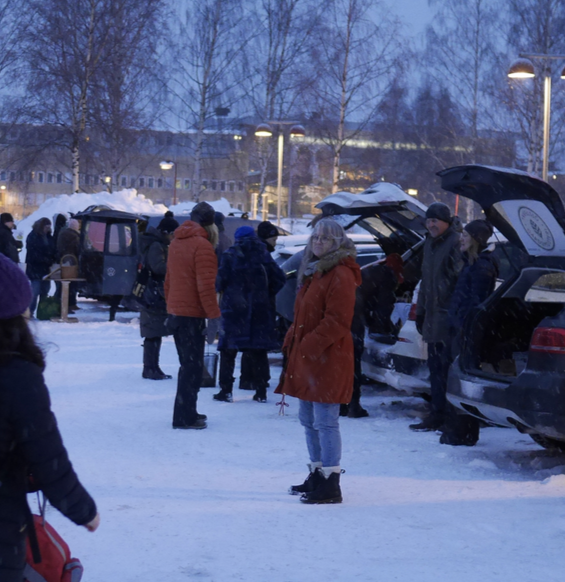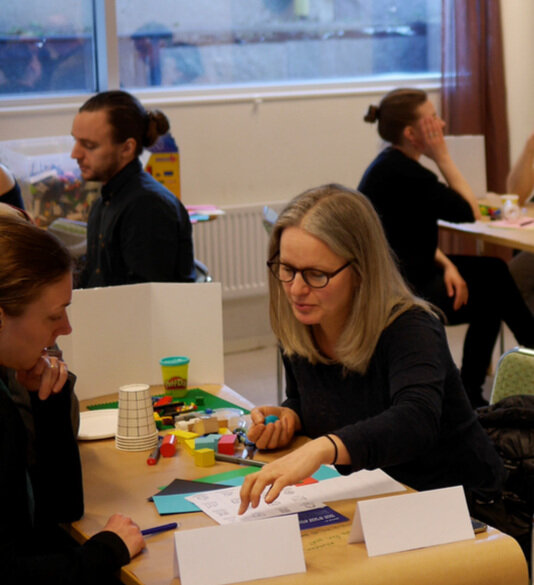The Harvest Network was the result of a six month thesis at the Interaction Design MFA program at Umeå Institute of Design.
Project Overview
This thesis explored design’s role in transitioning the Swedish food system to one that is more resilient to the shocks caused by climate change and in the context of the project duration, COVID-19. The project’s central question was: What does food citizenship look like in a resilient food system, and what design process is necessary to facilitate such a solution?
The project collaborated with a local food ecosystem startup, Harvest, which has the mission to improve the local food supply chain so everyone can eat deliciously and sustainability. Together with Harvest, the project developed a vision of what the local food ecosystem will look like in a viable world. It proposes that collective action around food is a possible vehicle for systems transition.
The resulting design is the proposition of a network that connects urban communities to local food producers while facilitating the support required to expand the production capability and stability of the local food ecosystem. The network is grounded in the design principles synthesized from the research conducted with the creative communities in Sweden that are working towards a resilient food system. The ideas of mutual aid and the permaculture ethics of people care and fair share have been guiding forces as supporting those living in transition is an essential element of food systems transition. From this proposition the project sets to explore what disruptive innovations need to occur in order to reach this vision. By framing the project in this way I aim to not only illuminate what the preferable future looks like and how it will function, but also illustrate how it is possible to reach this future.
Design Theory Exploration
The core Framework:
During the thesis I have been exploring what ways in which human- centered design can evolve and through this exploration I have found a process that has helped me as a designer to engage with systems transition. The CORE Framework owes inspiration from three primary sources: Bill Sharpe’s 3 Horizons Framework, transition design visioning, and speculative design practice. It is a tool for designers to identify, explore, and evaluate propositions for systems transition.
The framework is not intended to replace human-centered design, but rather provide another tool by which I as a designer could focus my a ention on facilitating systemic change. One of my initial research questions was: What tools do citizens need now to enable and support the transition to a resilient food system. Through the course of my project it became clear that in order to design tools that facilitate transition, I as a designer needed a be er set of tools. The CORE Framework is a proposition for how designers can work in order to be be er prepared to address systems transition.
The CORE Framework describes an approach that designers can take to identify what a viable world is, explore possibilities within this world, and evaluate these possibilities based on how they serve the core values of the viable world that is the aim of the transition. It is made up of two sections: now and future. The now section of the framework is primarily focused on building the core that will guide concept development and future propositions through design ethnography, participatory design, and speculative design practices. The future section is focused on the creation and evaluation of propositions and visions that embody the core values of the viable world.
Exploratory Research & Synthesis
Design Ethnography with Creative Communities
I took a design ethnography approach to gaining insights into the state of the Swedish alternative food network(s). I did not synthesize my research findings into personas that I would then use as the ‘user’ that I would then be designing for. My design question necessitated an ecosystem style understanding of the relationships between various actors within these food system constellations. Rather I mapped where these individuals fit into a community of eaters in contrast to individual eater relationships. By drawing a distinction between community and individual food behavior roles I was able to be er understand the conditions that facilitate collective action around food.
In addition to in field interviews and surveys I conducted multiple workshops with designers, farmers, and members of the local REKO in Umeå. These co-creation workshops served as a way to shape what a future food system could possibly look like. A theme from the workshops was idea of community negotiated principles and who has the power to decide these principles became an interesting way to frame this topic. The discussion around these principles revolved around the waste produced by the farming hubs, the transparency of the food information, and the facilitation of cooperation between local producers. Whithin the groups I worked with there was a strong desire to play an active role in defining and shaping their local food system.
“Matching my demand with the supply. It’s a challenge to find what you actually want. Search option would be great, or a wider variety of items on their sales list.”
Everyone eats, and ecosystem perspective
Building on the learnings from creative communities, a tool I used to sythesize the research findings was to map out the various roles within the Swedish food system. I used the criteria: buyer, non-buyer, seller, and producer. I did this for both individual eaters and communities of eaters. By mirroring community activity and individual activity I could better understand how various community innovations have filled the different roles possible within food systems.
As a designer, this type of synthesis allowed me to understand not just how one
individual’s challenges affects them in their everyday life, but allowed me to begin to analyze these tensions as they relate to their role in a local food ecosystem. An example of this is how an interviewee views her role as an urban permaculture gardener as a skill that will eventually be in demand and take action in making this pathway for change viable for others. She began the process of moving over to the community of eaters space in the local food ecosystem and is a member of a local community supported agriculture (CSA) farm. These types of personal transitions are the ones that I believe will be the driver behind a greater food system transition.
By being able to map the trajectory communities have made through this analysis I was able to better identify which journeys should and could be made easier through my eventual design concept.
Design Principles
I took the distilled my synthesis into a set of design principles that would guide how I moved forward into my concept ideation phase. These principles spoke to the journeys and ongoing social innovations that the communities I engaged with embodied. These principles shaped the next engagement I made with them in order to further explore how a service could be designed to further enable these innovations.
Criteria for concepts
Once I had gotten feedback and engaged with those I conducted my design ethnography with I moved into the system proposition phase of the project. These criteria speak to specific traits that the system proposition must embody in order to be aligned with not only the research phase, but also the feedback I received on the directions presented during the workshops. These criteria ensure that any concepts that I produce have a strong link back to the primary research.
Design Strategy & Concept
Harvest’s Strategy
Working with Harvest, I was able to outline how they can leverage their position as food hubs within the city. By creating a platform for their customers to easily order their vertically farmed produce as well as establish food cooperatives that could order directly from local farms Harvest could position itself as the infrastructure for a local food ecosystem. By positioning themselves in this way they would strengthen their relationship with the best local farmers and establish a strong customer base within the community. They would also position themselves well as a food supplier within a climate future that will undoubtedly experience shocks to the system that will impact food prices and availability. By establishing a diverse product offering through the close tie to local producers their luxury product of fresh salads would be less susceptible to market fluctuations.
A local food system proposition
The Harvest Network concept is a distributed network of Harvest Cooperatives, Harvest Hubs, and local farms that connects urban communities to local producers. It is facilitated by a platform that enables orders, logistics, and communication. It has the system goal of expanding & supporting a diversity of local food producers within the ecosystem by connecting urban communities with local producers, and transition to a more resilient food system in Umeå.
This concept builds on the foundation laid by the Harvest+ concept in the sense that it facilitates the growth of the local food ecosystem. It does this through the use of the Harvest Hubs as a physical space for order delivery, sorting and events combined with a digital platform for visualizing demand and product availability within the local food ecosystem. It also facilitates consumer requests for new produce as well as farmers requests for the support of expanded production. Through the facilitation of such a mutual aid infrastructure the system is able to re-organize and evolve in the way that the community and local producers require.
A Mechanism for food citizenship: The Harvest Network Platform
The platform is a digital tool that will be connecting and facilitating the logistics of the Harvest Network. This platform is a form of civic media in the sense that it enables the community to connect and strive together toward the common goal of supporting and building a strong local food ecosystem. The platform enables local food cooperatives to see the available food, place orders, and send production requests
The system’s goal is to support and expand the local food ecosystem of Umeå. As such, the Harvest platform enables a mutual aid support system that enables Harvest Cooperatives to request new produce production from the network of producers while farmers can request support from the network of cooperatives to facilitate production expansion. By having this capability the system is able to self-organize around what demand is in the system and respond to the shocks caused by climate change.
Opening Pathways for new food constellations
The end result of my platform proposition is a digital layer that makes the formation of self-organizing food system possible. Due to time constraints and a global pandemic that interrupted the project, the second iteration of the prototype was limited to brief community feedback. It did however begin to confirm that the platform facilitates new food system relationships and constellations.
“I can’t help but smile when I hear your concept because I always assume that people don’t want to help”
This platform facilitated the translation of local energy to support local producers into a service that enabled mutual aid and made it easy for the community to gain access to this produce. It provides value to both producer and consumer. Harvest is able to strategically position itself at he intersection of these two communities.










